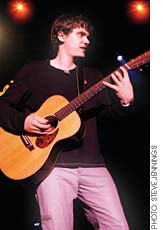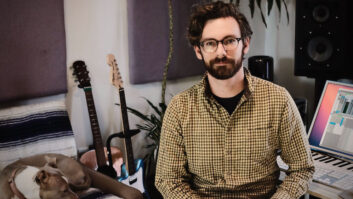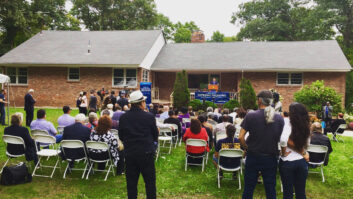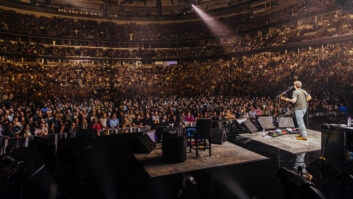
“You can rest your bones on me,” reads a large, whitesign held by one of the thousands of 20-something young women whojammed Concord, Calif.’s Chronicle Pavilion to hearguitarist/songwriter-turned-pop-wunderkind John Mayer. Dressed in baggyjeans and a long-sleeved, black T-shirt, Mayer, along withco-headliners the Counting Crows, had the packed house swaying andsinging to their respective sets of familiar hits, well-crafted albumcuts and outta-left-field cover tunes.
The 26-year-old Mayer built a vast network of MP3-downloading,tape-trading fans through rigorous touring and well-received effortssuch as the acoustic EP Inside Wants Out, a 1999 DIY projectreissued last year by Aware/Columbia. His sudden leap from AAA darlingto Grammy-winning pop artist, however, occurred in 2001, when Columbiareleased the now-triple-Platinum Room For Squares, a full-bandeffort showcasing his emotive songwriting and fluid melodies. Thissummer, Mayer hit the road in support of Any Given Thursday, thePlatinum-selling live DVD/CD released on Video/Aware in February. He’salso giving fans a taste of the Jack Joseph Puig-produced HeavierThings, which hits stores in September.
FOH engineers Chad Franscoviak (John Mayer) and Bruce Jones(Counting Crows) both worked on Harrison’s Showconsole, Dallas-basedShowco’s touring version of the Harrison Live Performance Console(LPC). The digitally controlled, analog audio mixing console featuresone centrally located, 16-fader subgrouping and auxiliary mastersection, flanked by two 20-fader input sections capable of controllingup to 80 live inputs. The console’s instantly recallable settings,combined with a sophisticated dynamics section, 4-band parametric EQand highpass filter, easily accommodated the three-act tour, which alsoincluded an opening slot shared by Maroon 5 and Graham Colton.
“It’s a great-sounding, intuitive console,” saysFranscoviak, an Atlanta-based studio and live engineer who beganworking with Mayer when he was still an up-and-coming club act andoccasional session musician. “Like any computer, though, you’vegot to speak kindly to it; make sure you’re on its good side thatday.”
Frequencies leaving the console are monitored with Metric Halo’sSpectra Foo software, which Franscoviak runs using the Metric HaloMobile I/O and a Macintosh G4 laptop. “You can visually referencehow the speakers, crowd and environment are influencing the mix, amongother things,” he says. He also uses an Earthworks omni mic forroom monitoring, and he records each concert using Tascam DA-78HR DTRSrecorders.
Franscoviak keeps outboard gear to a minimum, using theShowconsole’s onboard dynamics for most of the band’s guitars andkeyboards. Electric guitars are captured using a combination of ShureSM57 microphones and the Hughes & Kettner RedBoxes. For DavidLaBruyere’s bass, Franscoviak opts for a Summit TLA-100A tube-levelingamplifier, while J.J. Johnson’s drums are run through a pair of AvalonSP737 tube preamp/EQ/compressors. “I run the entire mix throughan Allen Smart C2 Compressor,” he adds. Franscoviak also uses aLexicon 480L R, TC Electronic M2000 Reverb and 2290 Delay, and anEventide H3000 for effects.

When it comes to outboard gear and microphone choices, Franscoviakadmits to “an incredible amount of experimenting” onMayer’s 40-date shed tour. “Almost every day I throw differentmics up on something.” For this particular concert, Franscoviakchose a Beyer TM88 and a Shure Beta 91 microphone for the kick drum, aNeumann KM 184 on the hi-hat, a Shure Beta 98 for the toms and an AKG414 for the overheads. A Shure SM57 captured the snare drum from thetop, while another AKG 414 took care of the bottom. Franscoviak alsoused a Shure Beta 98 as a snare-rim mic.
Bass and acoustic guitar both ran though the Avalon U5 InstrumentDI/preamp. Electric guitars were miked with Shure SM57s, while backingvocals ran through Shure Beta 58s. Meanwhile, Mayer’s own deep, breathyvoice translated well through a Shure SM86. “John’s vocals have alot of low-mid and high end, but not much midrange, and getting thatrequires a fair amount of soft compression,” Franscoviaksays.
Keeping Mayer’s rich vocals audible above a full rock band and acheering, singing audience presents yet another challenge.“John’s fans hang on every word, but that doesn’t keep them frombeing pretty loud themselves,” Franscoviak says. “On thelast tour, we played indoor venues, and the level coming from the crowdwould overpower the P.A. A lot of the fans sing along with the set, sokeeping the band up is always an interesting dilemma.”
For the outdoor tour, the Mayer crew relies on Showco’s PRISM SoundSystem, paired with the Clair iO loudspeaker controller manufactured byLake Technologies. Showco also provided invaluable tech service andsupport. “From my experience, it really performs best if youdon’t carve it up,” Franscoviak says of the PRISM system P.A.“It’s all about the right mics, direct boxes, pickups, all ofthat, as opposed to hacking away at the EQ. It’s the mostwell-thought-out P.A I’ve used, and gives very evencoverage.”
At the Chronicle Pavilion, the PRISM loudspeaker system includedfive columns of four Showco cabinets (they tour with eight columns offour per side), four front fills, four underfills and six subwoofersper side.
According to monitor engineer Adrian Silverstein, the Clair iO DSPspeaker controller provides excellent EQ for the Sensaphonics In-Earmonitors, worn only by Mayer and the technical engineers. “Johnsings so soft that the wedge just doesn’t help Chad outsonically,” says Silverstein, who worked for St. Louis-basedproduction company Airco Audio before hitting the road with Mayer lastyear. His career also includes a brief stint with Bon Jovi and the GooGoo Dolls, under the guidance of engineers Raza Sufi and Jon“Boo” Bruey. For Mayer and band, Silverstein runs eightmonitor mixes from the Shure PSM 700 beltpack transmitter/receiversthrough a Clair Bros. RF Power Amplifier, fused with ProfessionalWireless Systems Helical antenna.
Silverstein also uses a TC Electronic M5000 reverb — foundnext to the second Showconsole in the area affectionately referred toas “Monitor World” — on Mayer’s vocals. In fact, theM5000 is about the only piece of outboard gear Silverstein uses, due tothe Showconsole’s array of channel dynamics. “In my opinion, ifyou keep it simple, you’re going to get better results,”Silverstein says. “There’s less room for error and you’re goingto get a more natural tone.”
With minimal outboard gear, Silverstein created a natural-soundingmonitor mix, one that’s able to “breathe” with the music,yet remains audible. FOH mixes for both acts sounded balanced and,mercifully, far from ear-splitting.
Like Mayer, Bay Area rockers the Counting Crows evolved fromclub-crawling road warriors to a chart-topping arena act, bolstered bylandmark success of the 1993 August and Everything After. With abackdrop of mountainous Northern California behind them, theseven-piece played a half-acoustic, half-electric set that includedfavorites from their vast catalog (“Mr. Jones,”“Hangin’ Around” “Rain King”), as well as aspirited cover of the Grateful Dead’s “Friend of theDevil.”
Bruce Jones, a 30-year live sound veteran whose credits include REM,David Bowie, Rick James, Ted Nugent and Santana, among others, had hishands full accommodating seven musicians, four of whom changeinstruments from song to song. Guitarists Dan Vickrey, Matt Malley andDavid Bryson switched between bass guitar, banjo, mandolin and pedalsteel, while keyboardist Charles Gillingham played acoustic grand,Wurlitzer, Hammond B3 and accordion. “Then, of course, everybodywants to hear Adam’s [Duritz] vocals right out front,” Jonesadds. “You have to keep your hands on the faders at alltimes.”
Duritz’s distinctive voice stood out with the help of a Shure Beta87 microphone and Sony MU-1 reverb. Jones double-mikes the guitars,using a combination of Shure KSM 32s, Beta 56s and SM57s. Two Shure 91sand a 309 cover the kick drum, an SM57 captures the top of the snareand an 87 catches the shell “to get that fat snare sound,”Jones adds. Audience mics were also Shure models.
Jones keeps two mixes going, one for the live audience and another,with drums and vocals down, for the audience at home. “We releaseCDs of every show,” he says. “People can go to the Websiteand get the CD from the board. I burn straight onto a Sonyrecorder.”
For monitors, engineer Kory Carter faces the daunting task ofkeeping the seven-piece sonically happy, especially one reportedlyparticular lead vocalist. Six of the seven bandmembers wear UltimateEars in-ear monitors. “We have three floor monitors onstage, andall the rest is in-ear,” Carter says. His mix fills more than 50channels, but like Silverstein, the Los Angeles-based engineer usesminimal outboard gear. “We don’t use a lot of compression orgates because it’s all in the Showconsole,” Carter says, adding,“anything to keep it smaller!” He does use a Lexicon PCM 80reverb and BSS DPR-901 EQ on Duritz’s vocals, however.
Carter, who has worked with Counting Crows for more than seven ofhis 12 years as an engineer, has accompanied the band to small clubs,festivals and stadiums, including memorable dates with The Who, theRolling Stones and Santana. “A lot of the crew has been here aslong, if not longer, than me,” he adds.
Though different in style and background, both the Counting Crowsand John Mayer place high value on the live performance, and they allowfans to take the experience home with them, whether it be viadownloaded CD or taped in person. Mayer encourages and allowsaudiotaping, though no sound board or power feeds are provided. On thistour, like others from Mayer’s career, fans will have more than enoughset lists and stories to exchange. “I haven’t seen any two showsperformed the same,” Franscoviak says. “It’s differentevery night… although John’s gotten a lot better about followinga set list.”
San Francisco Bay Area-based freelance writer Heather Johnson isa frequent contributor to Mix.







